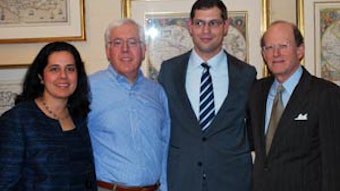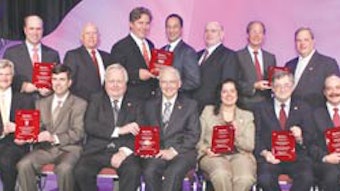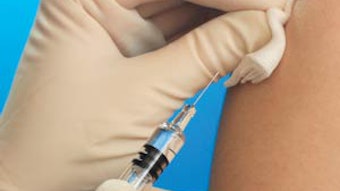Consensus Opinion: How to Code Balloon Sinus Dilation
Richard W. Waguespack, MD; Michael Setzen, MD; Michael J. Sillers, MD; Scott P. Stringer, MD The AAO-HNS submitted three new code requests in October 2009 to the American Medical Association (AMA) for Category I CPT codes for the use of stand-alone balloon sinus dilation technology during endoscopic sinus surgery. The AMA has accepted these new code proposals and has recommended work and practice expense relative value units (RVUs) to CMS for the new codes. These codes incorporated into CPT 2011 as follows: 31295 Nasal/sinus endoscopy, surgical; with dilation of maxillary sinus ostium (e.g., balloon dilation), transnasal or via canine fossa (Do not report 31295 in conjunction with 31233, 31256, 31267 when performed on the same sinus) 31296 with dilation of frontal sinus ostium (e.g., balloon dilation) (Do not report 31296 in conjunction with 31276 when performed on the same sinus) 31297 with dilation of sphenoid sinus ostium (e.g., balloon dilation) (Do not report 31297 in conjunction with 31235, 31287, 31288 when performed on the same sinus) The relative work values of these codes as adopted by CMS are 2.70 for 31295, 3.29 for 31296 and 2.64 for 31297. There are changes in the introductory language and new parenthetical notes related to existing endoscopic sinus surgery codes to account for these additions. Revised introductory guidelines A surgical sinus endoscopy includes a sinusotomy (when appropriate) and diagnostic endoscopy. Codes 31295-31297 describe dilation of sinus ostia by displacement of tissue, any method, and include fluoroscopy if performed. Codes 31233-31297 are used to report unilateral procedures unless otherwise specified. The parenthetical notes define which codes can be reported together. Dilation codes cannot be reported for the same sinus as existing corresponding resection codes. New exclusionary parenthetical notes 31233 Nasal/sinus endoscopy, diagnostic with maxillary sinusoscopy (via inferior meatus or canine fossa puncture) (Do not report 31233 in conjunction with 31295 when on the same sinus) 31235 Nasal/sinus endoscopy, diagnostic with sphenoid sinusoscopy (via puncture of sphenoidal face or cannulation of ostium) (Do not report 31235 in conjunction with 31297 when performed on the same sinus) 31256 Nasal/sinus endoscopy, surgical, with maxillary antrostomy; 31267 with removal of tissue from maxillary sinus (Do not report 31256, 31267 in conjunction with 31295 when performed on the same sinus) 31276 Nasal/sinus endoscopy, surgical with frontal sinus exploration, with or without removal of tissue from frontal sinus (Do not report 31276 in conjunction with 31296 when performed on the same sinus) 31287 Nasal/sinus endoscopy, surgical, with sphenoidotomy; 31288 with removal of tissue from the sphenoid sinus (Do not report 31287, 31288 in conjunction with 31297 when performed on the same sinus) The CPT Assistant article published in January 2010 will be largely superseded by the new codes. As always, if a service is not accurately described by an existing CPT code, the unlisted 31299 should be reported. The primary goal of endoscopic sinus surgery is relieving obstruction and re-establishing sinus ventilation and drainage. This is a generally accepted surgical principle that applies to all of the paranasal sinuses regardless of what instrumentation is used. With the introduction of balloon dilation technology, there is a recognized difference in the physician work involved between traditional endoscopic sinus surgery with tissue removal (bone, mucosa, polyps, tumor, and/or scar) and endoscopic sinus surgery when the balloon, or any device, is employed as a dilation tool only and no tissue is removed. When a balloon or other device is used to dilate a sinus ostium under endoscopic visualization as a standalone procedure and no tissue is removed, the correct reporting is the new corresponding dilation code. Fluoroscopy, if performed, is not reported separately. Balloon dilation of the maxillary ostium performed via the canine fossa approach with removal of tissue from the interior of the antrum is reported with 31299. If performed in a bilateral fashion, 31299, without modifier 50, is reported; this unlisted code should only be reported once per surgical session. Similar logic applies to the sphenoid sinus. This does not apply to endoscopic surgery of the ethmoid sinus as there is no current balloon technology for use in the ethmoid sinus. If ethmoidectomy is performed in conjunction with balloon dilation of the frontal, maxillary, and/or sphenoid (no tissue being removed), the appropriate ethmoid code should be reported in addition to the corresponding dilation code: 31254 Nasal/sinus endoscopy, surgical; with ethmoidectomy, partial (anterior), or 31255 Nasal/sinus endoscopy, surgical; with ethmoidectomy, total (anterior and posterior). Removal of ethmoid tissue as part of ethmoidectomy does not constitute tissue removal from the frontal, maxillary, and/or sphenoid sinuses if the balloon is used for dilation of these sinus ostia alone. The majority of endoscopic frontal sinus procedures focus on relieving obstruction in the frontal recess, the inferior aspect of the frontal sinus outflow tract, while others focus on enlarging the ostium. The goal of frontal sinus surgery, as with the other paranasal sinuses, is to relieve obstruction and re-establish ventilation and drainage. CPT code 31276 Nasal/sinus endoscopy, surgical with frontal sinus exploration, with or without removal of tissue from the frontal sinus describes the work performed as follows: Obstructing frontal recess cells, polyps, or scar tissue and intersinus septae from the dome of the ethmoid and skull base are delicately removed. It also may include removal of osteitic bone between the frontal sinus and a supraorbital ethmoid cell. The skull base is at significant risk for perforation resulting in CSF leak or intracranial bleeding. The following examples satisfy the criteria for reporting this code such that at the completion of a Draf I/IIA-B/III procedure, one can visualize the frontal sinus for exploration and proceed with removal of tissue from the frontal sinus, if performed: A Draf I frontal sinusotomy would include removing the posterior wall of the Agger nasi cells, the superior attachment of the bulla lamella of the ethmoid bulla, and/or Type I and II frontal cells. This removes tissue obstructing the frontal sinus and is not part of the typical ethmoidectomy. A Draf IIA frontal sinusotomy would include removal of a Type III frontal cell reaching into the frontal sinus. A Draf IIB/III (endoscopic modified Lothrop) frontal sinusotomy not only reaches the ostium but enlarges it with punches, drills, etc. There are instances in which the balloon is used to establish a pathway, through the frontal recess to the frontal sinus followed by tissue removal (mucosa, polyps, scar, tumor and/or bony partitions) with traditional instrumentation such as forceps and/or the microdebrider. In this instance, the balloon is used as an adjunct to traditional instrumentation. When the result is a frontal sinusotomy and tissue has been removed, the appropriate code is 31276 and the dilation is not separately reported. Similar rationale would apply to surgery involving the maxillary and sphenoid sinuses. If the balloon is used to dilate the sinus ostium and subsequently tissue is removed relative to that sinus, the appropriate maxillary sinus and/or sphenoid sinus codes is/are utilized. For example, if an endoscopic balloon dilation of the maxillary sinus is performed with a 6 mm balloon and the uncinate process is fractured and subsequently removed and/or peri-ostial polypoid mucosa is excised to create a sinuostomy, the appropriate code that describes the work performed is 31256 (Nasal/sinus endoscopy, surgical; with maxillary antrostomy). If 31256 is performed and mucosa is subsequently removed from the interior of the maxillary sinus, 31267 Nasal/sinus endoscopy, surgical; with removal of tissue from the maxillary sinus is utilized. Similarly, if the sphenoid sinus ostium is dilated with a balloon under endoscopic visualization and subsequently a portion of the superior turbinate, bone and/or peri-ostial polypoid mucosa is removed from the sphenoethmoid recess to further re-establish ventilation and drainage from the sphenoid sinus, 31287 Nasal/sinus endoscopy, surgical, with sphenoidotomy describes the work performed. Once the sphenoidotomy has been performed and if tissue is removed from the interior of the sphenoid sinus, 31288 Nasal/sinus endoscopy, surgical, with sphenoidotomy; with removal of tissue from the sphenoid sinus is reported. Unfortunately, having Category I CPT codes for sinus ostial dilation does not guarantee payment by all carriers as some designate the procedures “investigational” or “experimental.” This is a carrier determination, largely based on its internal interpretation of existing literature and current usage. The Academy periodically reviews the literature relating to levels of evidence to help demonstrate when new technologies, such as dilation, meet or exceed generally accepted criteria for reimbursement. If one must report 31299 for a service not described by existing codes, it is critical to accurately document all elements of the procedure. In order for the carrier to understand what was done surgically, a full and detailed explanation of the surgery needs to be documented in the accompanying letter of explanation appeal that should be sent to the carrier with a copy of the operative report. Both documents (as well as any communications needed to precertify the procedure) should explain in detail for each site what was done with respect to the unlisted procedure. If members have problems with respect to coding and reimbursement for these procedures, please contact the Academy’s Health Policy department at healthpolicy@entnet.org. To access this article, visit http://www.entnet.org/Practice/Coding-for-Balloon-Sinus-Dilation-2010.cfm.

The AAO-HNS submitted three new code requests in October 2009 to the American Medical Association (AMA) for Category I CPT codes for the use of stand-alone balloon sinus dilation technology during endoscopic sinus surgery. The AMA has accepted these new code proposals and has recommended work and practice expense relative value units (RVUs) to CMS for the new codes. These codes incorporated into CPT 2011 as follows:
- 31295 Nasal/sinus endoscopy, surgical; with dilation of maxillary sinus ostium (e.g., balloon dilation), transnasal or via canine fossa
(Do not report 31295 in conjunction with 31233, 31256, 31267 when performed on the same sinus) - 31296 with dilation of frontal sinus ostium (e.g., balloon dilation)
(Do not report 31296 in conjunction with 31276 when performed on the same sinus) - 31297 with dilation of sphenoid sinus ostium (e.g., balloon dilation)
(Do not report 31297 in conjunction with 31235, 31287, 31288 when performed on the same sinus)
The relative work values of these codes as adopted by CMS are 2.70 for 31295, 3.29 for 31296 and 2.64 for 31297.
There are changes in the introductory language and new parenthetical notes related to existing endoscopic sinus surgery codes to account for these additions.
Revised introductory guidelines
A surgical sinus endoscopy includes a sinusotomy (when appropriate) and diagnostic endoscopy. Codes 31295-31297 describe dilation of sinus ostia by displacement of tissue, any method, and include fluoroscopy if performed.
Codes 31233-31297 are used to report unilateral procedures unless otherwise specified.
The parenthetical notes define which codes can be reported together. Dilation codes cannot be reported for the same sinus as existing corresponding resection codes.
New exclusionary parenthetical notes
- 31233 Nasal/sinus endoscopy, diagnostic with maxillary sinusoscopy (via inferior meatus or canine fossa puncture)
(Do not report 31233 in conjunction with 31295 when on the same sinus) - 31235 Nasal/sinus endoscopy, diagnostic with sphenoid sinusoscopy (via puncture of sphenoidal face or cannulation of ostium)
(Do not report 31235 in conjunction with 31297 when performed on the same sinus) - 31256 Nasal/sinus endoscopy, surgical, with maxillary antrostomy;
- 31267 with removal of tissue from maxillary sinus
(Do not report 31256, 31267 in conjunction with 31295 when performed on the same sinus) - 31276 Nasal/sinus endoscopy, surgical with frontal sinus exploration, with or without removal of tissue from frontal sinus
(Do not report 31276 in conjunction with 31296 when performed on the same sinus) - 31287 Nasal/sinus endoscopy, surgical, with sphenoidotomy;
- 31288 with removal of tissue from the sphenoid sinus
(Do not report 31287, 31288 in conjunction with 31297 when performed on the same sinus)
The CPT Assistant article published in January 2010 will be largely superseded by the new codes. As always, if a service is not accurately described by an existing CPT code, the unlisted 31299 should be reported.
The primary goal of endoscopic sinus surgery is relieving obstruction and re-establishing sinus ventilation and drainage. This is a generally accepted surgical principle that applies to all of the paranasal sinuses regardless of what instrumentation is used. With the introduction of balloon dilation technology, there is a recognized difference in the physician work involved between traditional endoscopic sinus surgery with tissue removal (bone, mucosa, polyps, tumor, and/or scar) and endoscopic sinus surgery when the balloon, or any device, is employed as a dilation tool only and no tissue is removed.
When a balloon or other device is used to dilate a sinus ostium under endoscopic visualization as a standalone procedure and no tissue is removed, the correct reporting is the new corresponding dilation code. Fluoroscopy, if performed, is not reported separately. Balloon dilation of the maxillary ostium performed via the canine fossa approach with removal of tissue from the interior of the antrum is reported with 31299. If performed in a bilateral fashion, 31299, without modifier 50, is reported; this unlisted code should only be reported once per surgical session. Similar logic applies to the sphenoid sinus.
This does not apply to endoscopic surgery of the ethmoid sinus as there is no current balloon technology for use in the ethmoid sinus. If ethmoidectomy is performed in conjunction with balloon dilation of the frontal, maxillary, and/or sphenoid (no tissue being removed), the appropriate ethmoid code should be reported in addition to the corresponding dilation code: 31254 Nasal/sinus endoscopy, surgical; with ethmoidectomy, partial (anterior), or 31255 Nasal/sinus endoscopy, surgical; with ethmoidectomy, total (anterior and posterior). Removal of ethmoid tissue as part of ethmoidectomy does not constitute tissue removal from the frontal, maxillary, and/or sphenoid sinuses if the balloon is used for dilation of these sinus ostia alone.
The majority of endoscopic frontal sinus procedures focus on relieving obstruction in the frontal recess, the inferior aspect of the frontal sinus outflow tract, while others focus on enlarging the ostium. The goal of frontal sinus surgery, as with the other paranasal sinuses, is to relieve obstruction and re-establish ventilation and drainage.
CPT code 31276 Nasal/sinus endoscopy, surgical with frontal sinus exploration, with or without removal of tissue from the frontal sinus describes the work performed as follows: Obstructing frontal recess cells, polyps, or scar tissue and intersinus septae from the dome of the ethmoid and skull base are delicately removed. It also may include removal of osteitic bone between the frontal sinus and a supraorbital ethmoid cell. The skull base is at significant risk for perforation resulting in CSF leak or intracranial bleeding. The following examples satisfy the criteria for reporting this code such that at the completion of a Draf I/IIA-B/III procedure, one can visualize the frontal sinus for exploration and proceed with removal of tissue from the frontal sinus, if performed:
- A Draf I frontal sinusotomy would include removing the posterior wall of the Agger nasi cells, the superior attachment of the bulla lamella of the ethmoid bulla, and/or Type I and II frontal cells. This removes tissue obstructing the frontal sinus and is not part of the typical ethmoidectomy.
- A Draf IIA frontal sinusotomy would include removal of a Type III frontal cell reaching into the frontal sinus.
- A Draf IIB/III (endoscopic modified Lothrop) frontal sinusotomy not only reaches the ostium but enlarges it with punches, drills, etc.
There are instances in which the balloon is used to establish a pathway, through the frontal recess to the frontal sinus followed by tissue removal (mucosa, polyps, scar, tumor and/or bony partitions) with traditional instrumentation such as forceps and/or the microdebrider. In this instance, the balloon is used as an adjunct to traditional instrumentation. When the result is a frontal sinusotomy and tissue has been removed, the appropriate code is 31276 and the dilation is not separately reported.
Similar rationale would apply to surgery involving the maxillary and sphenoid sinuses. If the balloon is used to dilate the sinus ostium and subsequently tissue is removed relative to that sinus, the appropriate maxillary sinus and/or sphenoid sinus codes is/are utilized. For example, if an endoscopic balloon dilation of the maxillary sinus is performed with a 6 mm balloon and the uncinate process is fractured and subsequently removed and/or peri-ostial polypoid mucosa is excised to create a sinuostomy, the appropriate code that describes the work performed is 31256 (Nasal/sinus endoscopy, surgical; with maxillary antrostomy). If 31256 is performed and mucosa is subsequently removed from the interior of the maxillary sinus, 31267 Nasal/sinus endoscopy, surgical; with removal of tissue from the maxillary sinus is utilized.
Similarly, if the sphenoid sinus ostium is dilated with a balloon under endoscopic visualization and subsequently a portion of the superior turbinate, bone and/or peri-ostial polypoid mucosa is removed from the sphenoethmoid recess to further re-establish ventilation and drainage from the sphenoid sinus, 31287 Nasal/sinus endoscopy, surgical, with sphenoidotomy describes the work performed. Once the sphenoidotomy has been performed and if tissue is removed from the interior of the sphenoid sinus, 31288 Nasal/sinus endoscopy, surgical, with sphenoidotomy; with removal of tissue from the sphenoid sinus is reported.
Unfortunately, having Category I CPT codes for sinus ostial dilation does not guarantee payment by all carriers as some designate the procedures “investigational” or “experimental.” This is a carrier determination, largely based on its internal interpretation of existing literature and current usage. The Academy periodically reviews the literature relating to levels of evidence to help demonstrate when new technologies, such as dilation, meet or exceed generally accepted criteria for reimbursement.
If one must report 31299 for a service not described by existing codes, it is critical to accurately document all elements of the procedure. In order for the carrier to understand what was done surgically, a full and detailed explanation of the surgery needs to be documented in the accompanying letter of explanation appeal that should be sent to the carrier with a copy of the operative report. Both documents (as well as any communications needed to precertify the procedure) should explain in detail for each site what was done with respect to the unlisted procedure. If members have problems with respect to coding and reimbursement for these procedures, please contact the Academy’s Health Policy department at healthpolicy@entnet.org.
To access this article, visit http://www.entnet.org/Practice/Coding-for-Balloon-Sinus-Dilation-2010.cfm.










